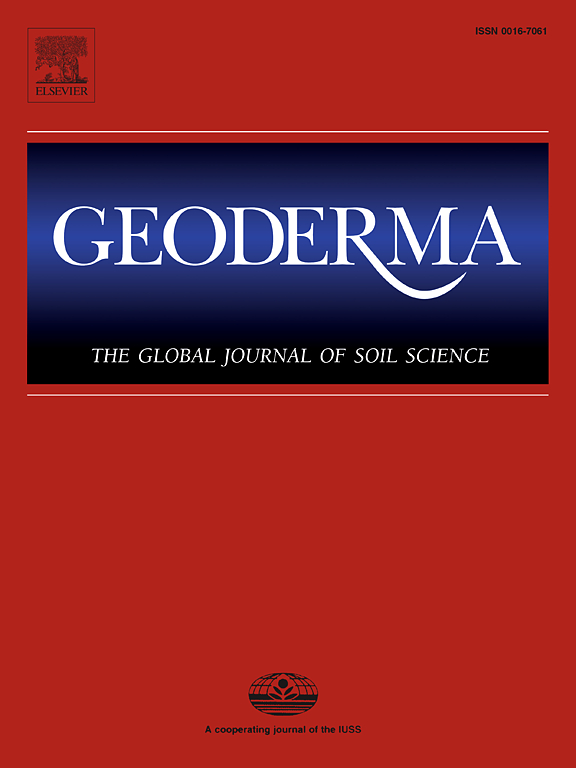Biochar’s electron shuttle potential mitigates N2O emissions by counteracting the stimulatory effect of rice root iron plaque
IF 5.6
1区 农林科学
Q1 SOIL SCIENCE
引用次数: 0
Abstract
Iron (Fe) plaque on rice roots can enhance nitrous oxide (N2O) emissions from paddy soil, primarily through Fe(II) oxidation-coupled denitrification. In this study, our hypothesis is that biochar will reduce N2O emissions via an electron shuttle and complete denitrification. To test this hypothesis, we performed laboratory microcosm experiments using a paddy soil-Fe plaque system amended with biochar. We examined the effects of biochar on soil N2O emissions, soil microbial community composition, and denitrifying functional gene. Furthermore, we evaluated potential correlations between biochar’s electron shuttle capacity and N2O emissions, as well as the N2O/(N2O + N2) ratio derived from denitrification processes.
Our results demonstrated that, in the absence of rice straw biochar, N2O emissions were doubled in the presence of Fe plaque. Interestingly, the addition of 1 % biochar to the paddy soil neutralized the difference in N2O emissions between the Fe plaque and control treatments. Furthermore, biochar addition enhanced the abundance of Fe(II)-oxidizing denitrifiers (e.g., Bacillus and Zoogloea) at the genus level and upregulated key denitrification functional genes (e.g., nirK and nosZ) associated with N2O mitigation. Importantly, oxidative treatment of biochar with H2O2 at varying concentrations reduced its electron donation capacity, which significantly weakened its ability to counteract Fe plaque-induced stimulation of N2O emissions. This efficacy was directly proportional to the biochar’s electron transfer capabilities.
These results highlight the critical role of biochar’s electron transfer function in counteracting the stimulatory effect of Fe plaque on N2O emissions. We conclude that adding biochar with strong electron transfer capabilities is a promising strategy to curb the Fe plaque-induced priming effect on N2O emissions in paddy soils. The application of just 1 % biochar at the rice seedling stage may effectively mitigate N2O emissions in paddy soils.

生物炭的电子穿梭电位通过抵消水稻根铁膜的刺激作用来减轻N2O的排放
水稻根系上的铁(Fe)斑块主要通过铁(II)氧化耦合反硝化作用增强水稻土的氧化亚氮(N2O)排放。在本研究中,我们的假设是生物炭将通过电子穿梭减少N2O排放并完成反硝化。为了验证这一假设,我们使用生物炭修饰的水稻土-铁斑块系统进行了实验室微观实验。研究了生物炭对土壤N2O排放、土壤微生物群落组成和反硝化功能基因的影响。此外,我们还评估了生物炭的电子穿梭能力与N2O排放之间的潜在相关性,以及反硝化过程产生的N2O/(N2O + N2)比率。我们的研究结果表明,在没有稻草生物炭的情况下,存在铁斑块的N2O排放量增加了一倍。有趣的是,在水稻土中添加1%的生物炭可以中和铁斑块和对照处理之间N2O排放的差异。此外,添加生物炭在属水平上增加了Fe(II)氧化反硝化菌(如芽孢杆菌和Zoogloea)的丰度,并上调了与N2O缓解相关的关键反硝化功能基因(如nirK和nosZ)。重要的是,用不同浓度的H2O2氧化处理生物炭会降低其电子给能能力,从而显著削弱其抵抗Fe斑块诱导的N2O排放刺激的能力。这种功效与生物炭的电子转移能力成正比。这些结果强调了生物炭的电子传递功能在抵消铁斑块对N2O排放的刺激作用中的关键作用。我们认为,添加具有强电子传递能力的生物炭是抑制水稻土中铁斑块诱导的N2O排放的一种有希望的策略。在水稻苗期施用1%的生物炭可有效减少水稻土中N2O的排放。
本文章由计算机程序翻译,如有差异,请以英文原文为准。
求助全文
约1分钟内获得全文
求助全文
来源期刊

Geoderma
农林科学-土壤科学
CiteScore
11.80
自引率
6.60%
发文量
597
审稿时长
58 days
期刊介绍:
Geoderma - the global journal of soil science - welcomes authors, readers and soil research from all parts of the world, encourages worldwide soil studies, and embraces all aspects of soil science and its associated pedagogy. The journal particularly welcomes interdisciplinary work focusing on dynamic soil processes and functions across space and time.
 求助内容:
求助内容: 应助结果提醒方式:
应助结果提醒方式:


